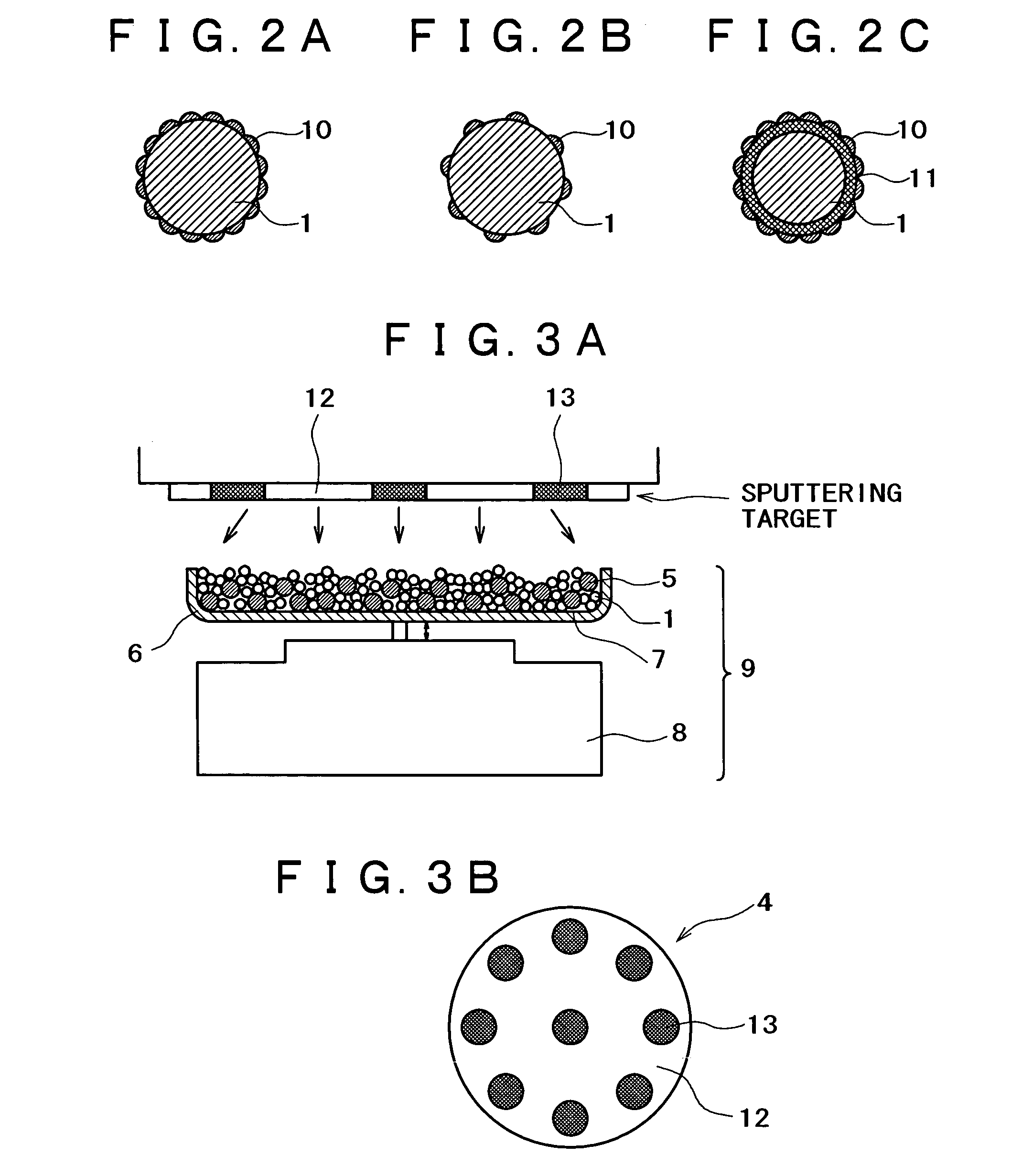Conductive catalyst particles and process for production thereof, gas-diffusing catalytic electrode, and electrochemical device
a technology of catalytic electrode and catalyst, which is applied in the direction of catalyst activation/preparation, metal/metal-oxide/metal-hydroxide catalyst, chemical/physical process, etc., can solve the problem of platinum which has been isolated from gas by the ionic conductor and is not functional any longer, and requires steps for reduction and thermal treatment. , to achieve the effect of less amount of catalytic material, good catalytic activity and good crystallinity
- Summary
- Abstract
- Description
- Claims
- Application Information
AI Technical Summary
Benefits of technology
Problems solved by technology
Method used
Image
Examples
example 1
[0150]An apparatus shown in FIG. 1 was assembled from a sputtering target, a vibrator, and a container. The container was charged with a conductive powder and balls. The sputtering target (shown in FIG. 1B) is a platinum disk 100 mm in diameter, which is incorporated with boron (B) in such an amount that the film formed by sputtering contains as much boron as shown in Table 1 given below. The balls are stainless steel balls 3 mm in diameter. The conductive powder is a carbon powder having a surface area of 800 m2 / g and an oil absorption value of 360 mL / 100 g. Sputtering is conducted with the vibrator generating vibration with an amplitude of ±1 mm and a frequency of 36 Hz.
[0151]The container was charged with the carbon powder (1 g) and the stainless steel balls (35 g). Sputtering was carried out for 30 minutes while the carbon powder and stainless steel balls were being vibrated by the vibrator, with the vacuum chamber supplied with argon (at 1 Pa) and the target activated by 400 W ...
example 2
[0158]The same procedure as in Example 1 was repeated to prepare a fuel cell as shown in FIG. 10, except that B was replaced by SiO2 and the amount of SiO2 was varied as shown in Table 2. The resulting fuel cells were tested for initial output and output after operation for 200 hours. The results are shown in Table 2 and FIG. 15. Incidentally, the initial output (in terms of mW / cm2) generated by the fuel cell which employs the gas-diffusing catalytic electrode containing no SiO2 is regarded as the standard (100%) for relative values.
[0159]
TABLE 2Output afterElementoperation for 200addedAmount added (mol %)Initial output (%)hours (%)SiO2010075SiO2110082SiO21.510085SiO22.0107100SiO22.5109107SiO23110108SiO25110110SiO210115115SiO220120120SiO230130130SiO240130130SiO250130130SiO260120120SiO265115115SiO270110110SiO2759595SiO2808080
[0160]It is shown that while Pt as the noble metal material and SiO2 as the additive material cannot be made into an alloy by chemical heating because SiO2 is so...
example 3
[0164]The same procedure as in Example 1 was repeated to prepare a fuel cell as shown in FIG. 10, except that B was replaced by Ga2O3 and the amount of Ga2O3 was varied as shown in Table 3. The resulting fuel cells were tested for initial output and output after operation for 200 hours. The results are shown in Table 3 and FIG. 16. Incidentally, the initial output (in terms of mW / cm2) generated by the fuel cell which employs the gas-diffusing catalytic electrode containing no Ga2O3 is regarded as the standard (100%) for relative values.
[0165]
TABLE 3Output afterElementoperation for 200addedAmount added (mol %)Initial output (%)hours (%)Ga2O3010075Ga2O3110082Ga2O31.510085Ga2O32.010295Ga2O32.510698Ga2O33110108Ga2O35110110Ga2O310110110Ga2O320110110Ga2O330110110Ga2O340110110Ga2O350110110Ga2O360110110Ga2O365110110Ga2O370110110Ga2O3759595Ga2O3808080
PUM
| Property | Measurement | Unit |
|---|---|---|
| specific surface area | aaaaa | aaaaa |
| diameter | aaaaa | aaaaa |
| diameter | aaaaa | aaaaa |
Abstract
Description
Claims
Application Information
 Login to View More
Login to View More - R&D
- Intellectual Property
- Life Sciences
- Materials
- Tech Scout
- Unparalleled Data Quality
- Higher Quality Content
- 60% Fewer Hallucinations
Browse by: Latest US Patents, China's latest patents, Technical Efficacy Thesaurus, Application Domain, Technology Topic, Popular Technical Reports.
© 2025 PatSnap. All rights reserved.Legal|Privacy policy|Modern Slavery Act Transparency Statement|Sitemap|About US| Contact US: help@patsnap.com



